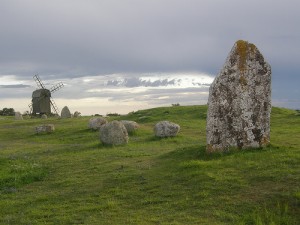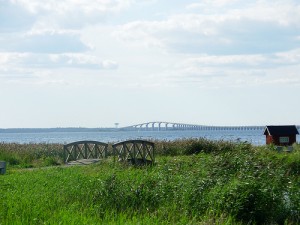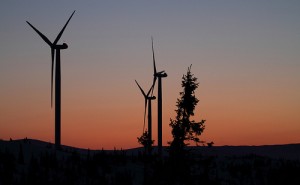Get your wind farm off my historic site: When visions of sustainability collide (Part 1)
03 February 2014 – Steven Burg

Öland’s landscape reflects 5,000 years of human habitation. Photo credit: Kim Bach
Off the east coast of Southern Sweden, a battle is raging between competing visions of sustainability. On the most unlikely of battlegrounds, bucolic Öland island, a desire to promote renewable energy has brought local officials committed to promoting a sustainable society into conflict with island residents, preservationists, farmers, environmentalists, and local business owners who believe that protecting the island’s character and cultural resources is incompatible with a proposal to expand industrially generated wind power on the island.
Öland is a rugged and beautiful strip of land surrounded by the Baltic Sea and linked to the mainland by the six-kilometer long Öland bridge. The island is dominated by a limestone plateau, sandy beaches, and a three-kilometer-wide swath of arable land along the southwest shore called Västra Landborgen. This place has supported human settlements for over 5,000 years. It is now a popular summer tourist destination and a favorite getaway of the Swedish royal family who maintain a palace, Soliden, on the island.

Öland is connected to the mainland by a six-kilometer-long bridge. Photo credit: Aitor Salaberria
Due to its relative isolation and limited development, portions of the island retain much of their medieval historical character. Today, the island’s farming communities continue to reflect land use patterns established approximately a thousand years ago, including linear villages and a continued division of agricultural lands into “infields” and “outfields.” The limestone plateau, Stora Alvaret, remains largely undeveloped and home to a unique and diverse island ecosystem.
In 2000, UNESCO’s (United Nations Educational, Scientific, and Cultural Organization’s) World Heritage Committee recognized the island’s transcendent value as a cultural resource by inscribing the “Agricultural Landscape of Southern Öland Island” on its list of World Heritage Sites.
Öland is also special in another way: its strong winds and the flat, open landscape of its limestone plateau make it an ideal site for generating wind power. Wind power has been actively developed in Sweden, particularly since the nation adopted a new national energy policy in 2009 that focused on achieving “ecological sustainability, competitiveness and security of energy supply.” In 2012, Kalmar County officials adopted a bold Island Sustainable Energy Plan that sought a fifty percent reduction in carbon emission by 2020.

Sweden’s ambitious renewable energy program supports the addition of more large wind turbines like these at Storrun Wind Farm. Photo credit: Lars Falkdalen Lindahl
To reach those goals, local officials are planning new industrial wind farms on the island—including one that will position a pair of 150-meter tall wind turbines within the boundaries of the World Heritage site. In response to concerns raised by UNESCO about the impact of the project, the county governor of Kalmar convened a meeting with “local and regional decision makers” as well as the local World Heritage site’s Management Council. At that meeting, all parties invited to the meeting concluded that the project would have no impact on the World Heritage property.
However, some local residents disagreed, and a group of 112 Öland residents petitioned UNESCO protesting that the project posed a serious threat to the World Heritage site. In a letter written to UNESCO World Heritage Centre director Kishore Rao, the group noted that UNESCO had recognized Öland as a site where “land use has changed little since the Stone Age,” a standard they felt should be maintained. They also felt that Sweden had ignored its treaty obligations under the World Heritage Convention of 1985 that required signatories to take legislative and administrative measures to protect cultural and natural resources.
The petitioners also raised concerns about the impact the wind farm might have on heritage tourism. They cited a survey that showed that the World Heritage Site had surpassed Öland’s beaches as the most attractive draw for tourists. As Fritz Eriksson, the first signatory of the letter to UNESCO, explained to a reporter from Swedish Radio, “People come for the untouched nature and the stunning scenery. So reasonably, Öland will be worse off if the tourists do not come.”
After evaluating the wind farm project, UNESCO officials concluded that placing the turbines within Öland‘s World Heritage site would “destroy the actual reason that justified the inclusion into the list. “ If the project were completed, UNESCO warned, “The Agricultural Landscape of Southern Öland will be at high risk to lose the grounds of its nomination and Outstanding Universal Value.” Nevertheless, the project continues to move forward.
(Part 2 follows.)
~ Steven Burg is Professor of History & Chair of the History and Philosophy Department at Shippensburg University of Pennsylvania. In the fall of 2013, he received a Fulbright Scholar’s grant to study approaches to historic preservation and public history in the Kingdom of Sweden.




Interesting post, Steve! In Central New York, I often see anti-wind power signs and am somewhat puzzled by them. There’s one about 15 miles from Cooperstown that says something like: “Wind power destroys friendships and communities.”
One need only delve into the details of one large scale wind energy facility to understand why there is strong and growing opposition. Indeed, even the AWEA has admitted that “the more people know about wind, the less they like it.”